Enjoy the fluffy, rich flavor of eggs paired with a savory sauce over rice! Tenshinhan is a Chinese-inspired Japanese dish that has been popular in Japan for decades. My recipe features an umami-rich sauce with a deep flavor that perfectly complements the eggs.
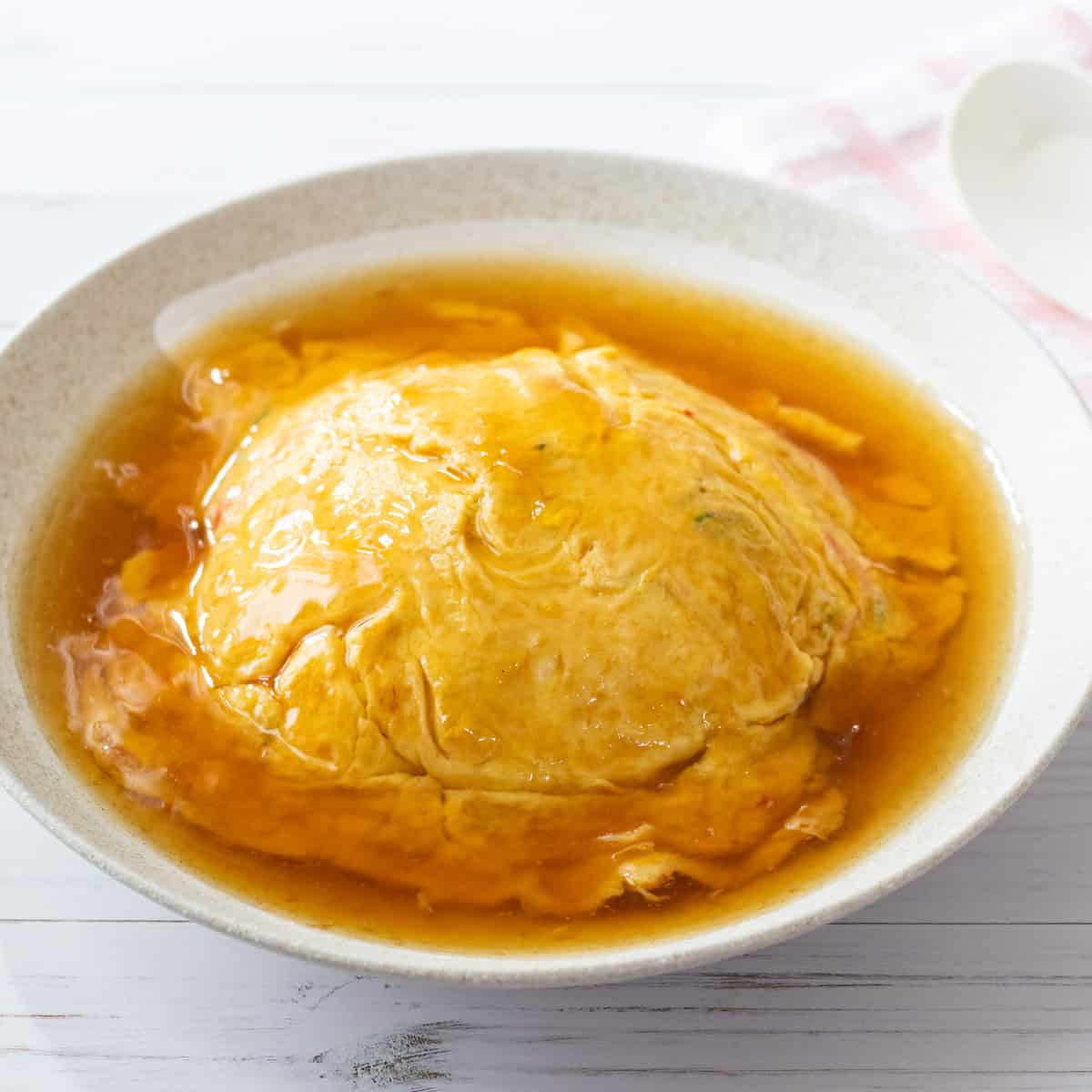
Jump to:
What is Tenshinhan?
Tenshinhan is a Japanese dish inspired by Chinese cuisine, made by cooking beaten eggs with ingredients like imitation crab and green onions (scallions), placing the omelet over rice, and then covering it with a flavorful, thick sauce. “Tenshin” refers to the Chinese city of Tianjin, and “han” means rice. That said, the dish itself doesn’t actually exist in Tianjin—or anywhere else in China. It is said that Japanese Chinese-style restaurants named it this way to give it a Chinese feel.
There are two main origin stories: one credits the dish to "Rairaiken" in Tokyo, while another points to "Taishoken" in Osaka. Perhaps because of this, the texture of the eggs and the flavor of the sauce vary widely depending on the region.
In the Kanto region (eastern Japan), including Tokyo, the eggs are usually cooked more firmly and topped with a rich, sweet-and-sour sauce. In contrast, in the Kansai region (western Japan), including Osaka, the eggs are cooked soft and fluffy, and the sauce tends to be lighter and soy-based. Since I live in Osaka, the recipe I’m sharing here follows the Kansai style.
When you look at the photos of the fluffy eggs in this recipe, you might think it requires special skills, like making an authentic omelet—but there is no need to worry. As long as you follow a few simple tips, anyone can make it successfully. The harmony of the eggs, the sauce, and the rice makes for a truly satisfying dish, so be sure to try making it in your own kitchen.
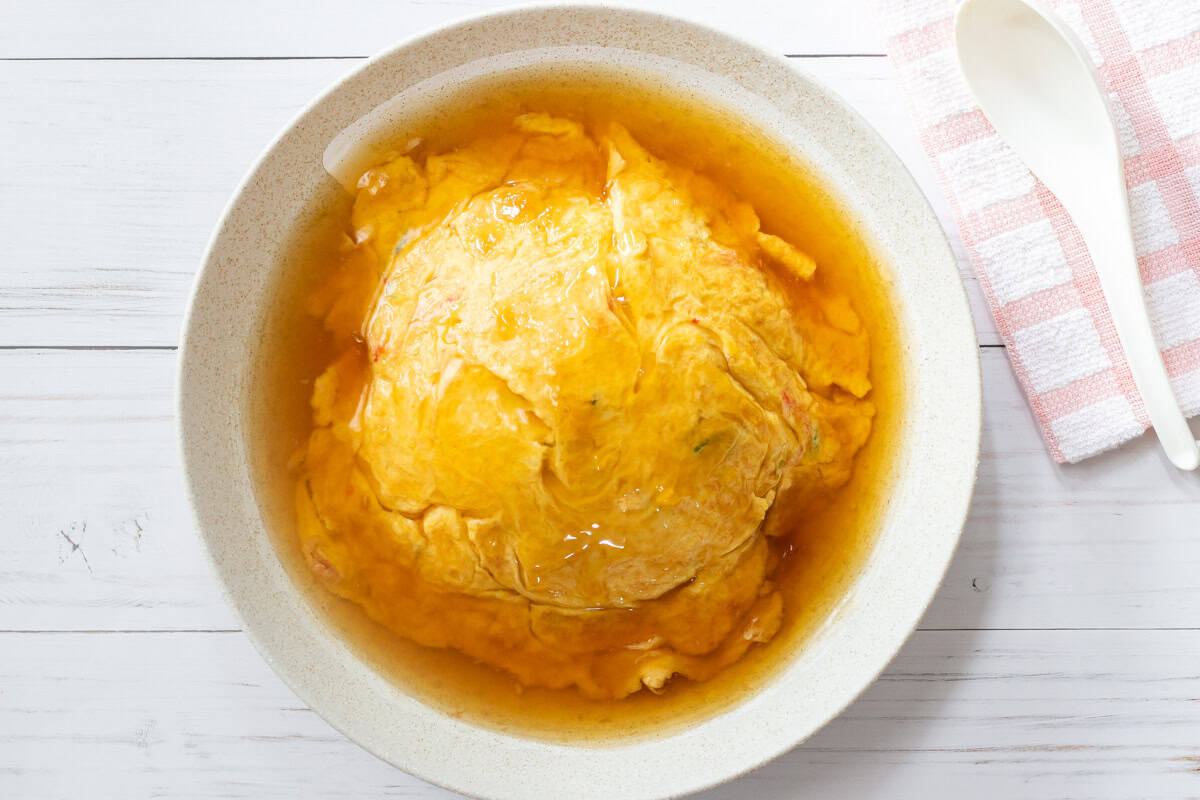
How to make a fluffy omelet
Tenshinhan consists of three key components: rice, an omelet, and sauce. What makes it so delightful is how these elements come together in perfect harmony. Let’s start by taking a look at the omelet.
The omelet in this dish typically includes a variety of ingredients in addition to eggs, such as:
- Imitation crab (or real crab)
- Green onions (scallions)
- Shiitake mushrooms
- Bamboo shoots
These ingredients add depth of flavor to the omelet while also making it more colorful and appetizing. For the record, imitation crab is used more often than real crab because real crab is expensive and not always easy to find. In this recipe, I use imitation crab along with green onions—but of course, you can use real crab or other ingredients of your choice.
Once you mix these ingredients into the beaten eggs and cook them, the omelet is ready. However, the key characteristic of the omelet in Kansai-style tenshinhan is its soft, fluffy texture. To achieve this, keep the following tips in mind:
- Beat the eggs thoroughly until the yolks and whites are fully combined.
If streaks of egg whites remain, they can prevent the omelet from cooking evenly. Use a whisk to ensure the mixture is smooth.
- Coat the pan with plenty of oil and cook the eggs while mixing the oil.
The oil not only prevents the eggs from sticking to the pan but also coats them lightly. This helps to trap moisture inside the eggs, contributing to a fluffy texture.
- Cook the eggs quickly over high heat.
High heat allows the outside of the eggs to set instantly while keeping the inside fluffy. Aim for a cooking time of less than 1 minute on the stove. If you use lower heat, the omelet will cook uniformly and lose its signature delicate, fluffy texture.
The sauce for Kansai-style tenshinhan
The sauce is also an essential element of tenshinhan.
It is very easy to make—just add water and seasonings to a pot, bring it to a boil, and then thicken it with starch dissolved in water. For a more refined flavor, let it simmer briefly to eliminate any powdery texture.
In the Kansai region, this sauce is typically lighter and more delicate in flavor. The distinctive feature of Kansai-style sauce is that it doesn’t have a strong taste; rather, it provides a subtle depth that complements the egg's natural flavor. Since it has such a gentle taste, I recommend pouring it generously over the omelet.
Shaping the rice into a dome
Once you place the omelet and sauce on top of the rice, your tenshinhan is ready to serve.
The rice used is regular cooked Japanese white rice, but the way it is plated is slightly different. Pile the rice into a dome shape in the center of a plate large enough to hold the omelet and sauce. This allows the sauce to spread naturally across the plate when poured. Compared to serving the rice flat, this method helps the sauce cling nicely to the omelet, making it even more enjoyable.
A simple way to do this at home is to first scoop the rice into a bowl, then turn it out onto a plate. This way, you can plate the rice neatly.
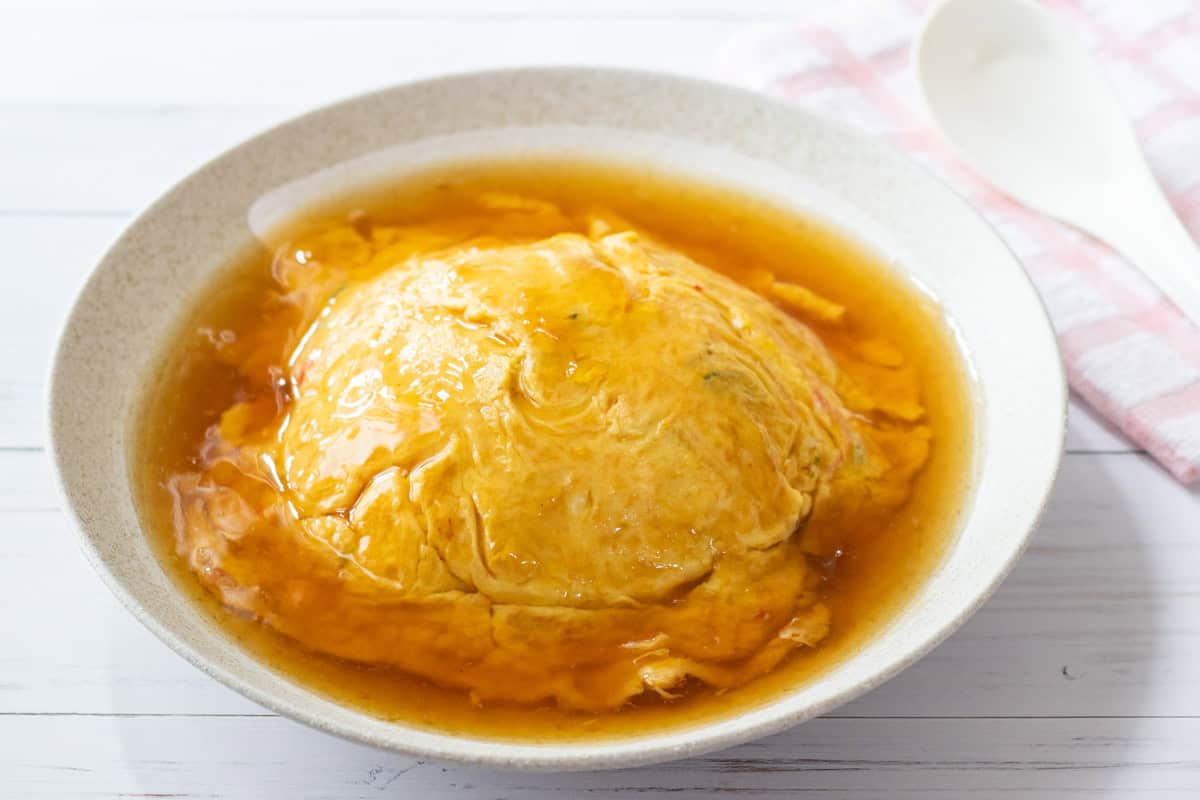
📋Step-by-step recipe
Ingredients
- 5.6 oz cooked Japanese white rice
For the sauce:
- 1 cup water
- ½ tsp Chinese-style chicken bouillon powder
- ½ tsp ginger (grated)
- 1 tsp sugar
- 1 Tbsp soy sauce
- 1 tsp oyster sauce
- 1 Tbsp potato starch or cornstarch
- 1 Tbsp water (for the starch)
For the omelet:
- 3 large eggs (about 2.1 oz/60 g each, including shell; if egg safety is a concern, use pasteurized eggs)
- a pinch of salt
- 1 oz imitation crab or real crab
- 1 Tbsp green onions (scallions) or Japanese leek (naganegi) (finely chopped)
- 1 Tbsp neutral oil
Instructions
🕒 Total: 15 mins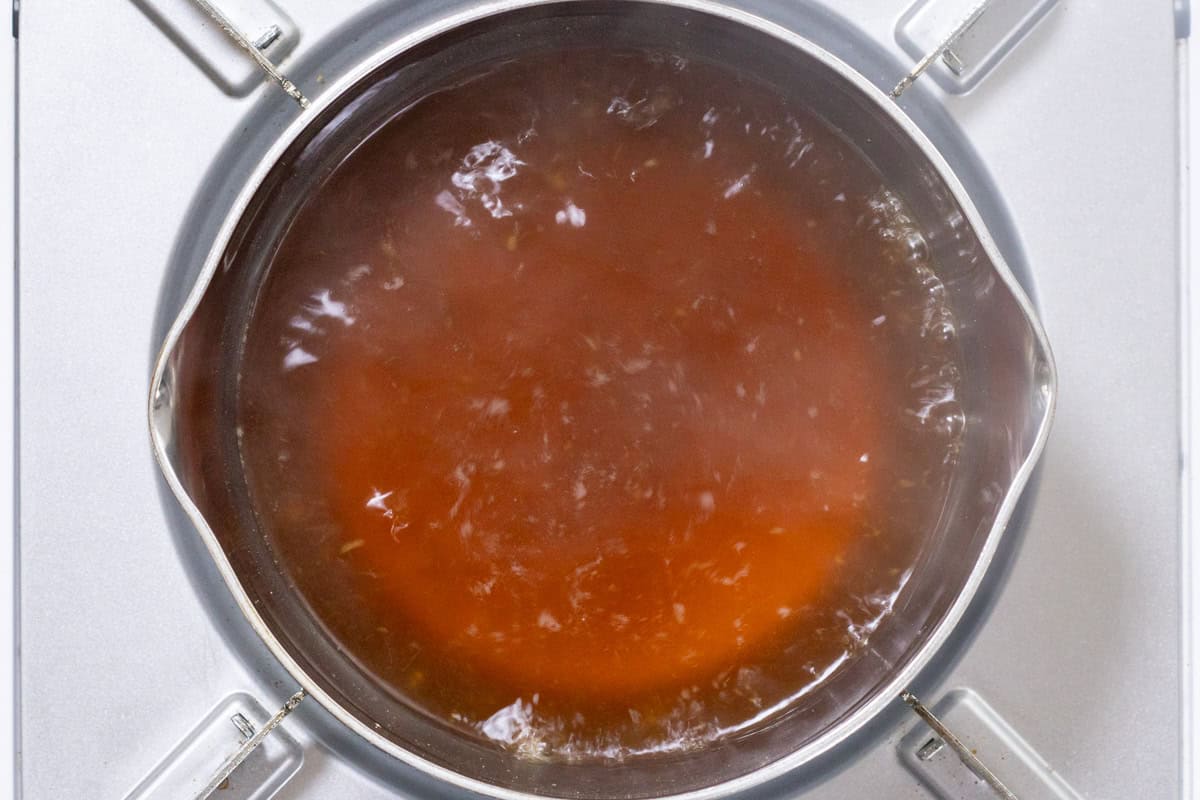
Step 1
In a small pot, combine water, chicken bouillon powder, grated ginger, sugar, soy sauce, and oyster sauce, then bring it to a boil. Meanwhile, mix the starch with water in a small bowl until smooth.
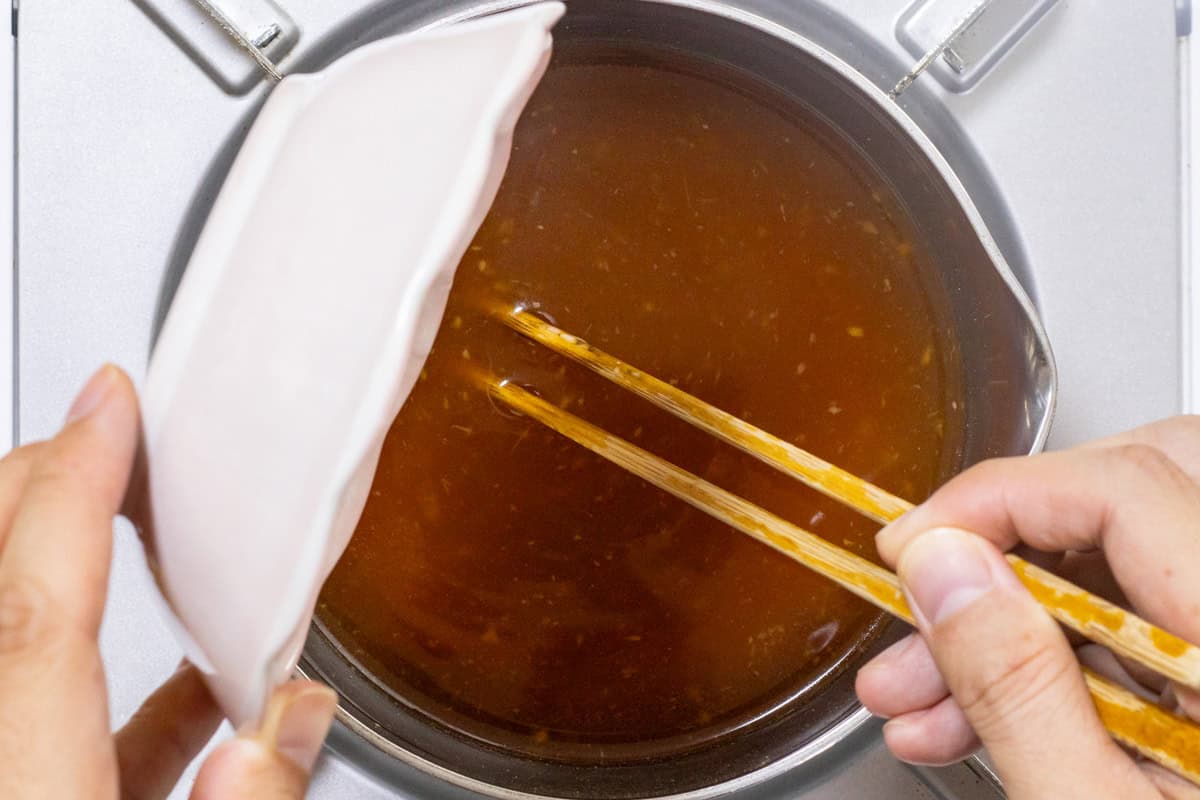
Step 2
Once the mixture comes to a boil, gradually add the dissolved starch while stirring constantly to thicken it and avoid lumps. Continue simmering for about 20 seconds to eliminate any powdery taste. The sauce for tenshinhan is ready.
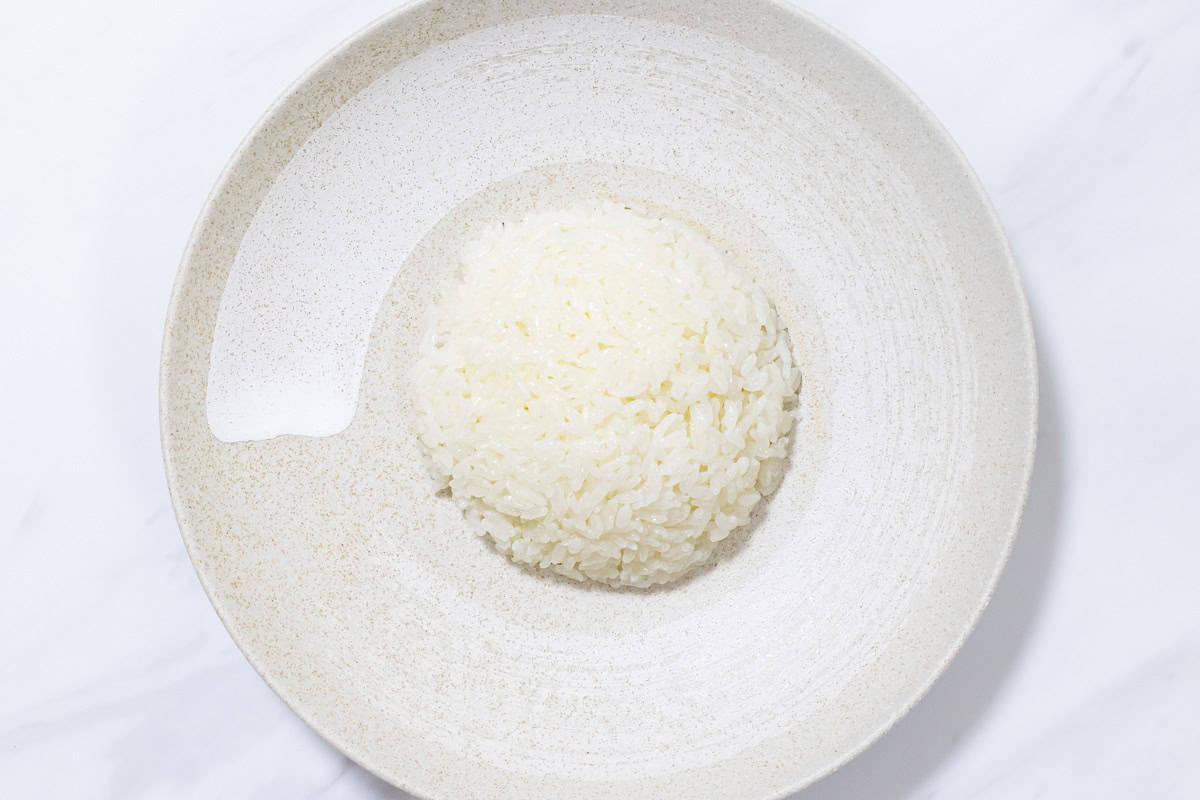
Step 3
Scoop the rice into a bowl, then turn it out onto the center of a large plate to form a dome-shaped mound.
To prevent the sauce from spilling after pouring, use a plate with a slight inward curve toward the center.
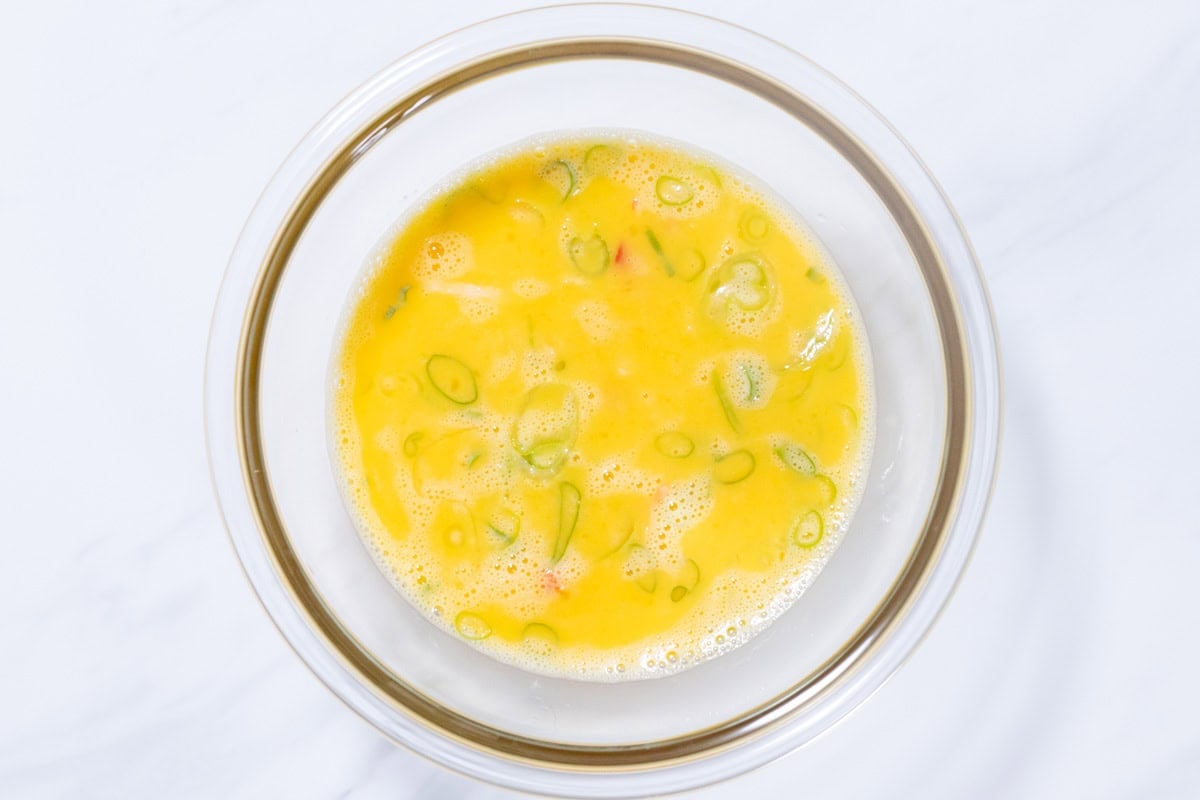
Step 4
In a separate bowl, crack the eggs, add salt, and whisk until no streaks of egg whites remain. Break the imitation crab into pieces and add it to the bowl along with green onions, then mix everything together.

Step 5
Heat oil (as specified in the recipe) in a pan over high heat. Once the pan is hot, pour in the egg mixture and stir quickly with a spatula while mixing it with the oil. Then, shape the egg into a round form.
The cooking time for the egg mixture at this step is about 30-40 seconds. When preparing this dish for 2 or more servings, be sure to cook each omelet separately; cooking all of the egg mixture at once can lead to uneven cooking and make it difficult to achieve a soft, fluffy texture.
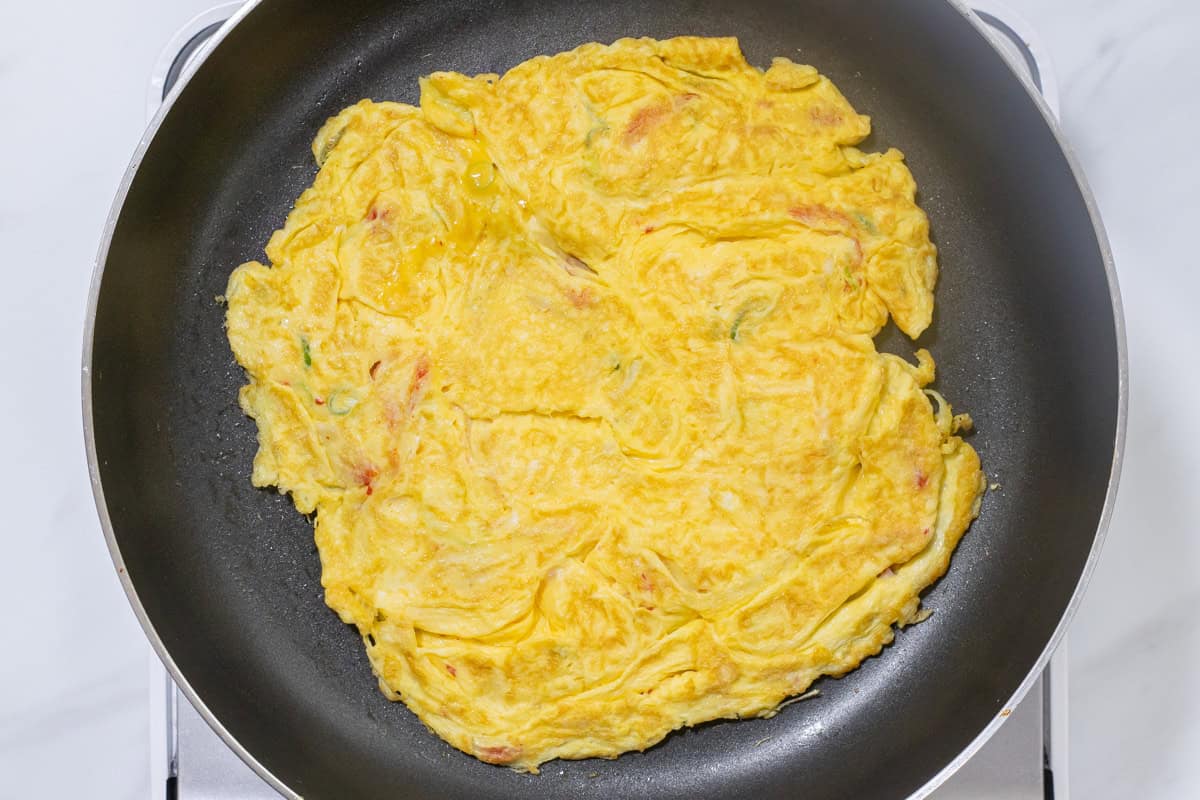
Step 6
Once the egg slides easily in the pan, flip it over and cook the other side for about 5 seconds.
Move on to the next step before the egg cooks too much from residual heat.
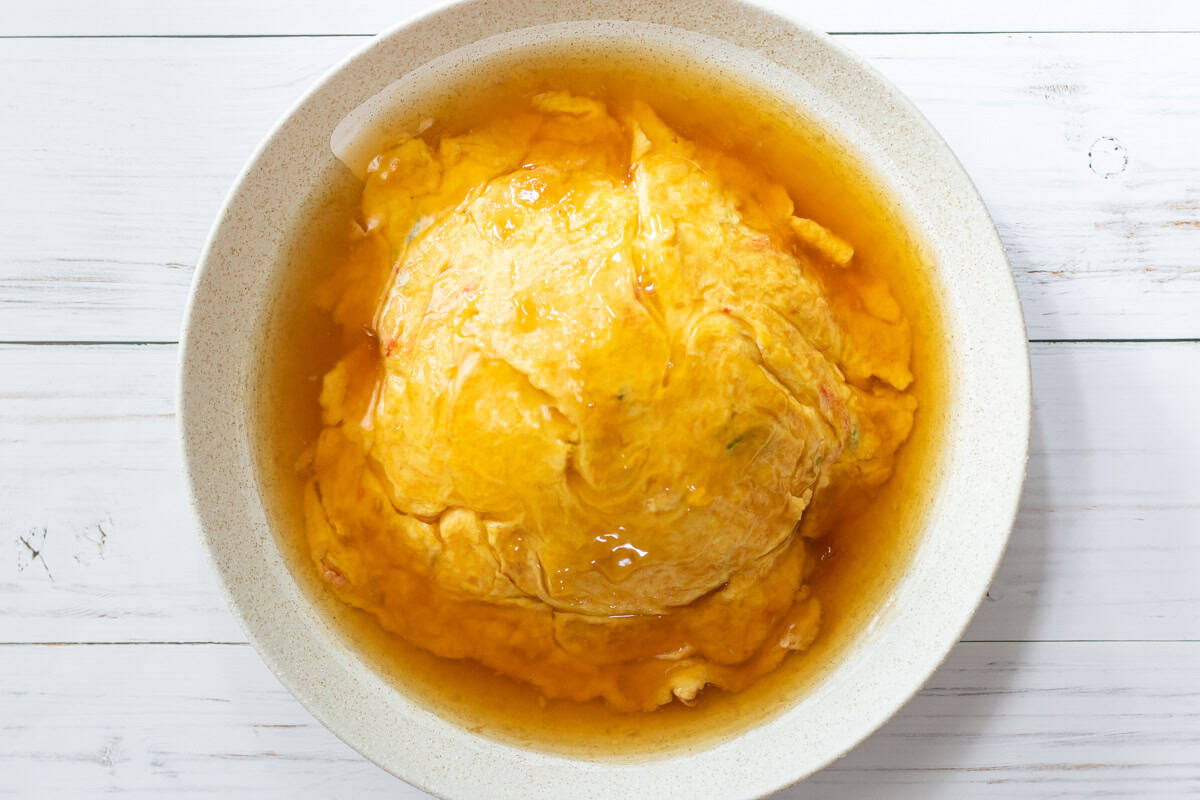
Step 7
Place the omelet on top of the rice on the plate, and pour the sauce over it.
If the sauce has cooled, reheat it before pouring it over the omelet. If you feel there is too much sauce, use only as much as you prefer.
To store
For the best texture, eat it as soon as possible after making it. You can store it in the refrigerator for up to half a day, but be sure to reheat it in the microwave, covered with plastic wrap or a microwave-safe lid, until the omelet is heated through.
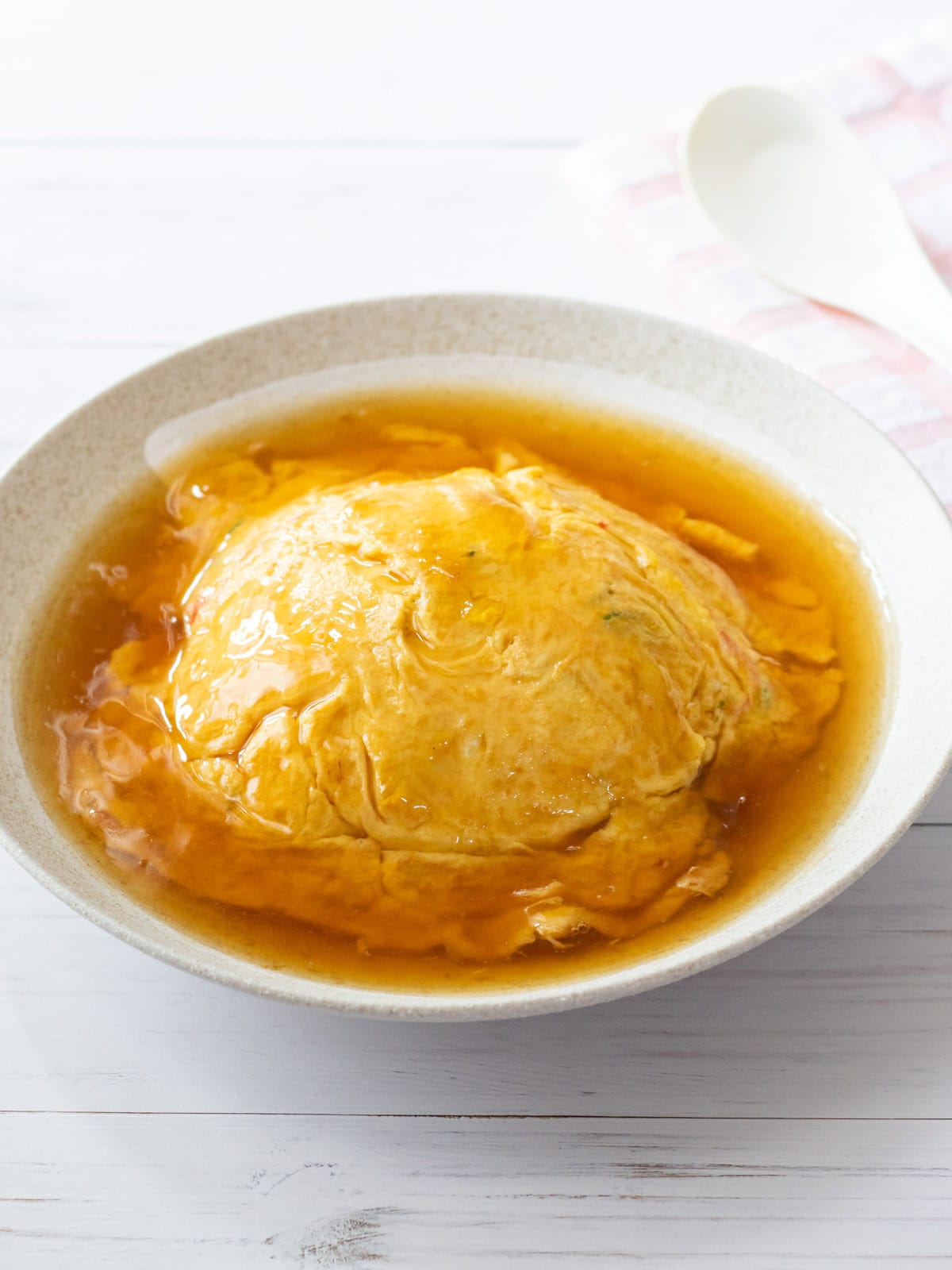
If you try this recipe, I’d love to hear what you think. Please consider leaving a review and star rating in the comments below. If you enjoyed it, I’d really appreciate it if you shared it with your friends.
More Chinese-inspired Japanese recipes you'll love
FAQ
Push the pan forward slightly, then quickly flick your wrist back toward you. The omelet will lift into the air, and you can use that momentum to flip it over. If you’re not comfortable handling the pan this way, just use a spatula to flip it instead.
You could, but that’s actually a feature of Kanto-style (Eastern Japan) tenshinhan. In the Kansai-style (Western Japan) version, like in my recipe, it’s not common to top it with green peas.
Recipe card

Tenshinhan (Fluffy Omelet over Rice with Sauce)
Ingredients
- 5.6 oz cooked Japanese white rice
For the sauce:
- 1 cup water
- ½ tsp Chinese-style chicken bouillon powder
- ½ tsp ginger (grated)
- 1 tsp sugar
- 1 Tbsp soy sauce
- 1 tsp oyster sauce
- 1 Tbsp potato starch or cornstarch
- 1 Tbsp water (for the starch)
For the omelet:
- 3 large eggs (about 2.1 oz/60 g each, including shell; if egg safety is a concern, use pasteurized eggs)
- a pinch of salt
- 1 oz imitation crab or real crab
- 1 Tbsp green onions (scallions) or Japanese leek (naganegi) (finely chopped)
- 1 Tbsp neutral oil
Instructions
- In a small pot, combine water, chicken bouillon powder, grated ginger, sugar, soy sauce, and oyster sauce, then bring it to a boil. Meanwhile, mix the starch with water in a small bowl until smooth.
- Once the mixture comes to a boil, gradually add the dissolved starch while stirring constantly to thicken it and avoid lumps. Continue simmering for about 20 seconds to eliminate any powdery taste. The sauce for tenshinhan is ready.
- Scoop the rice into a bowl, then turn it out onto the center of a large plate to form a dome-shaped mound.To prevent the sauce from spilling after pouring, use a plate with a slight inward curve toward the center.
- In a separate bowl, crack the eggs, add salt, and whisk until no streaks of egg whites remain. Break the imitation crab into pieces and add it to the bowl along with green onions, then mix everything together.
- Heat oil (as specified in the recipe) in a pan over high heat. Once the pan is hot, pour in the egg mixture and stir quickly with a spatula while mixing it with the oil. Then, shape the egg into a round form.The cooking time for the egg mixture at this step is about 30-40 seconds. When preparing this dish for 2 or more servings, be sure to cook each omelet separately; cooking all of the egg mixture at once can lead to uneven cooking and make it difficult to achieve a soft, fluffy texture.
- Once the egg slides easily in the pan, flip it over and cook the other side for about 5 seconds.Move on to the next step before the egg cooks too much from residual heat.
- Place the omelet on top of the rice on the plate, and pour the sauce over it.If the sauce has cooled, reheat it before pouring it over the omelet. If you feel there is too much sauce, use only as much as you prefer.
Notes
- For the best texture, eat it as soon as possible after making it. You can store it in the refrigerator for up to half a day, but be sure to reheat it in the microwave, covered with plastic wrap or a microwave-safe lid, until the omelet is heated through.

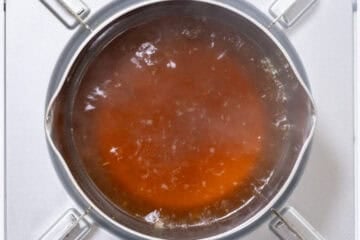
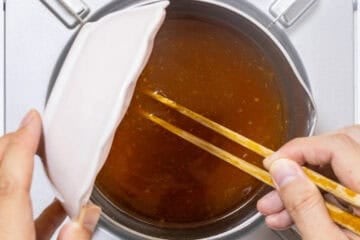
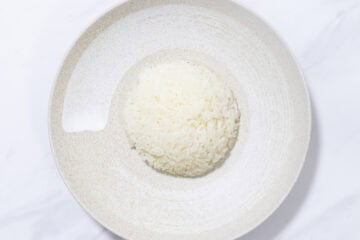




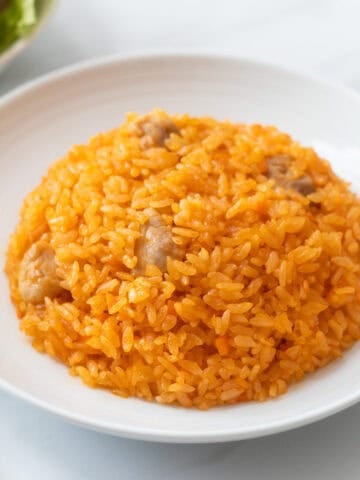
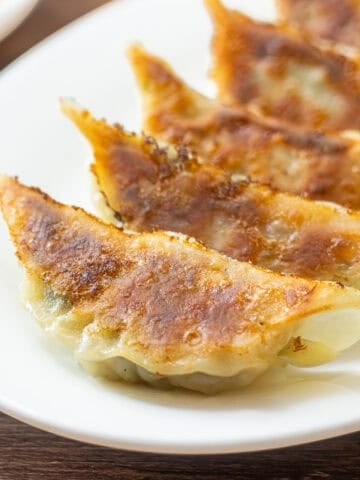
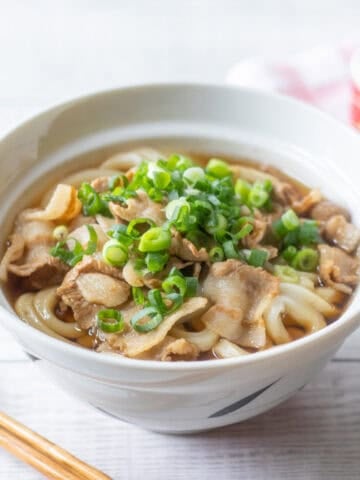

Leave a Rating and a Comment